How to Cook Monkfish
This post may contain affiliate links. Please read the disclosure policy.
Learn how to cook monkfish for a delicious seafood dinner! Monkfish has a meaty texture with a sweet and mild taste, earning it the nickname poor man’s lobster. It doesn’t flake or fall apart like more delicate fish, making it suitable for pan-frying, grilling or baking in the oven.

Monkfish is one of my favorite seafood choices. Not only is it affordable and widely available, but the meaty flesh has a deliciously mild and slightly sweet flavor. This taste has earned monkfish the nickname poor man’s lobster and explains why it graces the menus of upscale restaurants the world over!
Today we’re preparing my favorite pan-fried monk fish with a simple lemon butter sauce, but you can also grill it or bake in the oven. So what are we waiting for? Let’s get started!
What Is Monkfish
Monkfish is a bottom-feeder coming from the sea floor with a fearsome appearance! Belonging to the genus Lophius, it goes by many names including munkfish, goosefish, stargazer, American angler, lotte, sea devil and frog fish. The American catch comes from the Northwest Atlantic with a season that lasts from November through June.
In spite of its nightmarish looks, monk fish has lots going for it! First, it’s a budget-friendly fish with good availability. Second, the rich flavor and meaty texture make it a delicious seafood option. Third, this anglerfish is entirely wild-caught with sustainable seafood ratings from the NOAA and Fish Choice. Fourth, there are a variety of health benefits including just 110 calories in a 6-ounce serving.
What Does Monkfish Taste Like? Monkfish has a mild and slightly sweet taste. The texture is firm and does not flake apart when cooked. It often draws comparisons to lobster or scallops because of its dense and meaty flesh.
The Monkfish Fillet
The only edible part is the monkfish tail, which gets cut into fillets by fishmongers. Since they can be quite thick pieces, I like to cut them in half lengthwise down the middle to create more slender pieces for more even cooking and an attractive serving presentation.
The Membrane: I suggest removing the grey membrane that may be present, as it’s somewhat chewy. Usually it will already have been removed on frozen fillets, but will be often be there on fresh monkfish. I always ask the fishmonger to trim it off for me, but you can also do it off yourself with a butcher’s knife.

How to Cook Monkfish
Cooking monkfish doesn’t need to be complicated, and you can use the stovetop, grill or oven. This recipe is as simple as seasoning it with salt and pepper before pan-frying in butter and olive oil. Add some fresh lemon and optional parsley before serving and you’re done. Marinating is an option but not a requirement. You got this!
Start by preparing the monkfish. Pat dry with paper towels and then trim off the membrane if necessary. Then cut the fillets lengthwise down the middle if the pieces are large. Season with salt and pepper.
Place a nonstick skillet over medium-high heat and and add the olive oil and butter (the olive oil prevents the butter from burning). As soon as the butter foams, use kitchen tongs to place the fillets in the pan. Cook for 3 to 5 minutes per side depending on thickness, spooning pan juices on top of the fish every few minutes. Garnish with droplets of freshly squeezed lemon juice and freshly chopped parsley to serve.

If you want some other ways to cook monkfish, try the following:
- Baked Monkfish: This is a great option for thicker fillets that are difficult to cook evenly on the stovetop. Preheat the oven to 400°F. Add olive oil and butter to a hot ovenproof skillet on the stovetop. Fry the fish for 2 minutes per side. Then transfer to a 400°F oven for another 5-10 minutes until done. Sprinkle with lemon juice and fresh parsley before serving.
- Grilled Monkfish: Preheat the grill to 400°F. Brush the monkfish fillets all over with a high-temperature oil like canola and then season with salt and pepper. Clean the grill grates thoroughly and spritz with nonstick cooking spray. Place the fillets on the grill for 3 to 4 minutes with the lid closed. Then flip and grill until done. (Note: You can also cube the fillets to make skewers.)
When Is Monkfish Done?
You want to monitor closely during cooking, since monkfish cooks quickly and can become chewy when overcooked. A 1-inch thick fillet needs just 6 to 8 minutes of total cooking time, but a thick piece could take up to 15 minutes.
The surface should feel firm and slightly springy when done, but I always suggest checking doneness using an instant-read thermometer inserted into the center of the fillet. A reading of 135°F / 57°C indicates medium doneness where the flesh is just opaque and flakes easily.
The safe internal temperature for fish where all bacteria has been killed is 145°F / 63°C according to the USDA. However, be forewarned that monkfish will be slightly chewy at that stage.
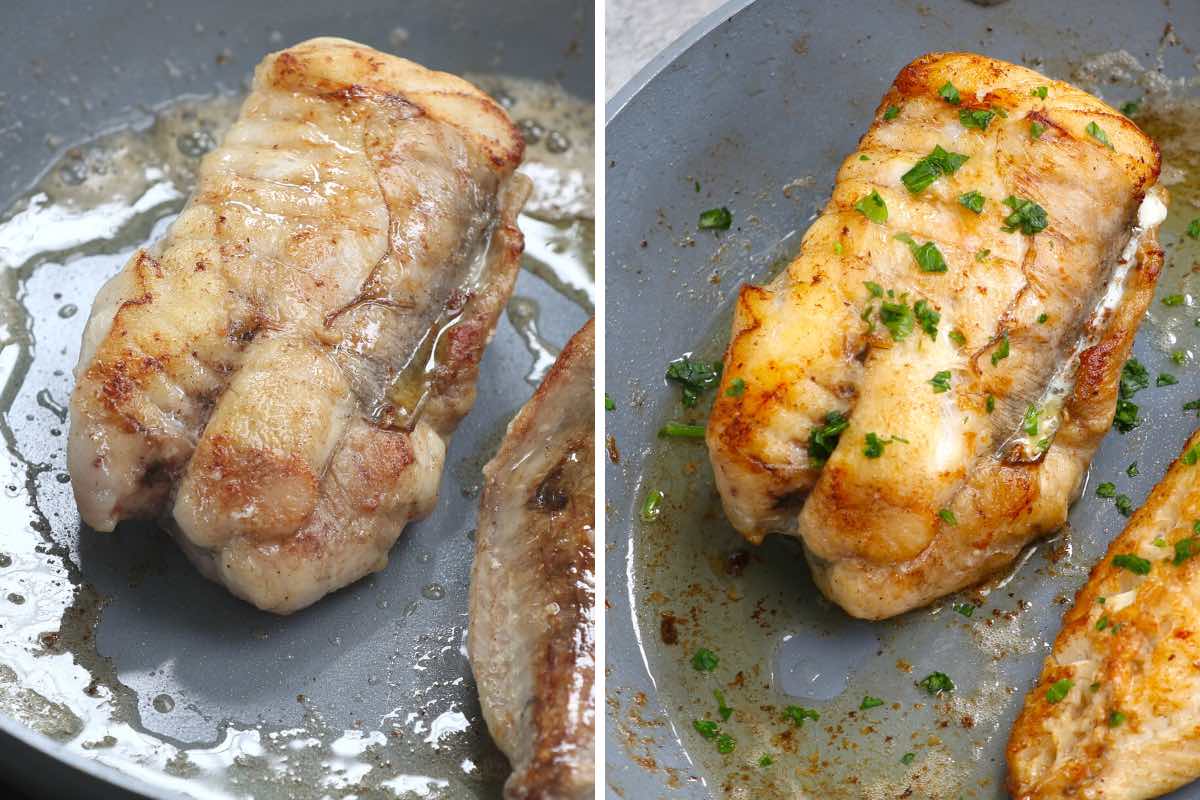
Tips for the Best Monkfish
- Pat dry the fish with paper towels to remove wetness that will interfere with browning. This way, you’ll get more flavor and color. If the fish is frozen, it has to be completely thawed before proceeding.
- Cut the monkfish into similar size pieces so they cook at the same speed. That way, you won’t be waiting for one fillet to finish while the other ares are cooling down.
- Baste the fish at least once during cooking to keep it moist and flavorful. Simply spoon juices from the pan onto the fish using a large, shallow spoon.
- Use a fish spatula to easily transfer the fillets to and from the heat source. This will prevent the disappointment of a fillet breaking apart when using a regular spatula or tongs.
- Avoid overcooking by using an instant-read thermometer to check the internal temperature. This is the best way to get the doneness just right.
- Transfer to a wire rack after cooking if you are not serving right away. This step will prevent the bottom of the fish from becoming mushy.
Recipe Variations
Several of you asked for more recipe variations, so here are some of our faves:
- Garlic and herb: You can add more robust flavors to this recipe if you wish. Try adding a teaspoon of minced garlic and fresh or dried thyme halfway through cooking. The flavors will infuse as the fish cooks.
- White wine sauce: If you have some extra wine on hand, try adding 1/2 cup to the pan halfway through cooking to create a white wine sauce you can drizzle on the fish before serving.
- Mediterranean style: Brown the fillets in the pan with garlic and onion for several minutes. Then add 1 cup chopped tomatoes, olives and dried oregano, cover and let the fish stew for 5 to 10 minutes until done.
- Cajun style: Rub the fillet with a teaspoon or more of cajun seasoning for some southern flavor and heat.
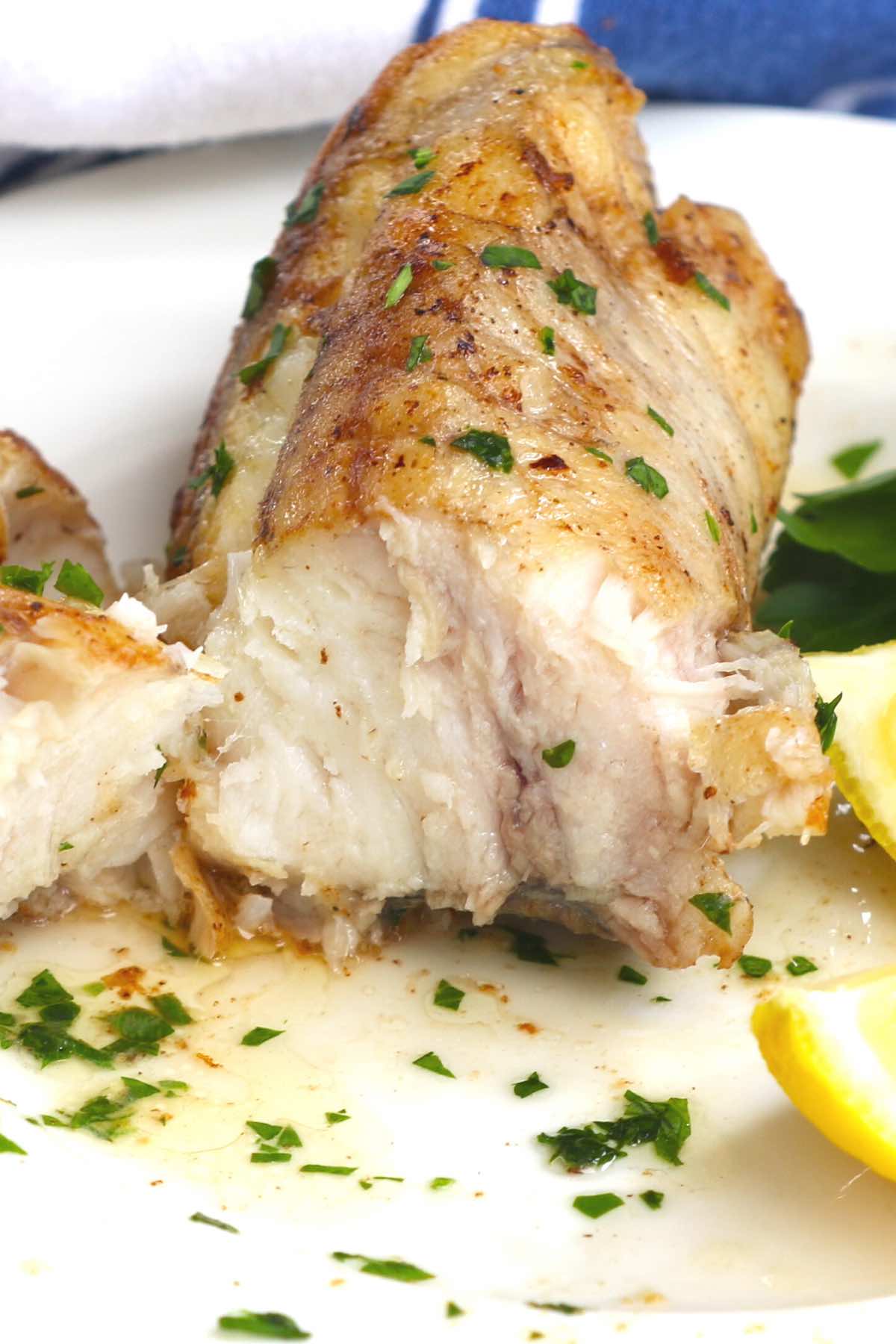
Ways to Serve Monkfish
You can use monkfish to make many different seafood entrees including fish tacos, kebabs, paella (seafood rice) and more. However, you can just as well serve the fillets whole with your favorite side dishes:
- Starches such as Mashed Potatoes, Boiled Potatoes, Steamed Rice, Cauliflower Rice, Pasta, and Mac and Cheese
- Vegetables including Broccoli, Corn on the Cob, Carrots, Green Beans, Spinach, Parsnips, Bok Choy, Brussel Sprouts
- Salads such as a crisp Green Salad, Potato Salad, Apple Salad, Cole Slaw and Pasta Salad
- Condiments including Pico de Gallo, Mango Salsa, Chimichurri Sauce, Hollandaise and Beurre Blanc sauces
You May Also Like:


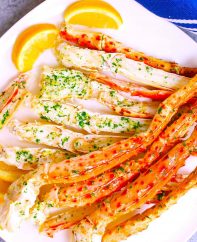

Monkfish with Lemon Butter Sauce (Poor Man’s Lobster)
Ingredients
- 2 pounds monkfish fillets, 4 to 6 fillets, fresh or frozen
- 2 tablespoons olive oil, divided
- 2 tablespoons butter, unsalted recommended
- 1 lemon, one half cut into wedges for serving
- 1/2 teaspoon salt, or to taste
- 1/2 teaspoon black pepper, freshly ground
- 1 tablespoon fresh parsley, chopped fine (optional)
Instructions
- Place the monkfish fillets on a work surface. If previously frozen, ensure they have thawed completely before proceeding.
- Pat dry with paper towels to remove excess moisture. If skin or the grey membrane is present, use a butcher's knife to remove it. Slide the blade beneath and work it back and forth to trim off the membrane/skin (optional but recommended).
- If the fillets are large, cut in half lengthwise down the middle to create strips 1-2 inches thick (2 1/2 – 5 cm). This step will help them to cook quickly and evenly.
- Rub the fillets all over with 1 tablespoon olive oil. Then season generously with salt and pepper.
- Place a nonstick skillet oven medium-high heat. When hot, add the butter and remaining 1 tablespoon olive oil to the pan. Swirl the pan to coat.
- Add the monkfish fillets to the pan. Fry undisturbed for 3 minutes to let the fish start browning.
- Using a fish spatula or kitchen tongs, carefully flip each fillet. Spoon pan juices on top to baste the fish. Continue cooking as little as 3 minutes more for one-inch fillets and up to 12 minutes for large fillets.
- Check doneness by inserting an instant-read thermometer into the center of the fillet. It will be rare at 125°F (52°C), medium at 135°F (57°C) and well-done at the USDA safe temperature of 145°F (63°C). If you don't have a thermometer, slide a knife tip 1/4-inch into the thickest section and twist slightly to expose the flesh. If it's translucent and flakes easily, the fish is done.
- Remove the fillets to a plate. Use a half lemon to sprinkle droplets of juice onto the fish along with optional parsley. Drizzle pan juices on top as well. Serve warm with lemon wedges.
Notes
- Grilled Monkfish: Preheat the grill to 400°F (205°C), preparing the monkfish fillets in the meantime. Clean the grill grates thoroughly and spritz generously with nonstick cooking spray to prevent sticking. Place the fillets on the grill to cook for 6 to 12 minutes with the lid closed (time depends on fillet size). Check doneness following the procedure above and remove to serving plates when done.
- Baked Monkfish: Preheat the oven to 400°F (205°C) with the rack in the upper middle position and forced air/convection turned on. Prepare the monkfish fillets as described above. Place a large ovenproof skillet on medium-high heat. Add olive oil and butter to the pan and fry the fish for 2 minutes per side. Using oven mitts, transfer the pan to the oven to continue cooking for 3 to 10 minutes (depending on fillet size). Check doneness as explained above and remove to serving plates when done.
- Doneness Tip: If you are cooking fillets of varying sizes, remove the thin fillets to a serving platter first and tent with foil to keep warm while the remaining fillets continue cooking.
Please read our nutrition disclaimer.

© TIPBUZZ. Images and text on this website are copyright protected. Please do not post or republish without permission. If you want to republish this recipe, please link back to this post. This post may contain affiliate links. Read the disclosure policy here.


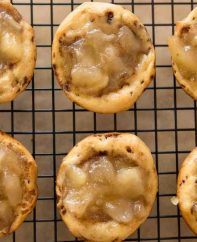



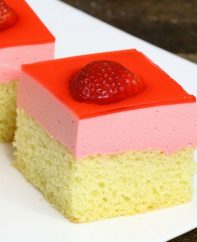

Monk fish is hard to find so when I found it at a store which I don’t visit often I bought 2 pieces. I followed the recipe to a “T” and we loved it. Wonderful flavor and texture.
Hi Nancy, So great to hear and thanks for your feedback. I know what you mean about it being difficult to find sometimes.
Thank you for your lovely recipe,I cooked it for my daughters 40th birthday she said it was amazing I will use it again many times thank you
Hi Ann, Congratulations on a successful celebration – I couldn’t be happier for you! Thanks for your comment.
I would like to bake the monkfish in the oven from start to finish. Could you please tell me how long to bake it and at what temperature? (400 degrees Fahrenheit?) TIA!
Hi Sheryl, Thanks for your question. It will take about 12 to 15 minutes in the oven at 400 depending on the thickness of the fillets. You can always insert an instant-read thermometer, which will read 145 deg F when it’s done. Hope that helps!
The recipe was great but instead of parsley i used English thyme. Really delucious!!
Hi Lily, Thanks for your feedback and glad you enjoyed! Thyme would be delicious too!
This recipe was so good! I have never cooked monkfish before, but the recipe was easy to follow and it turned out great! Adding to our rotation
Hi Jenni, Great to hear that and thanks for leaving a comment!